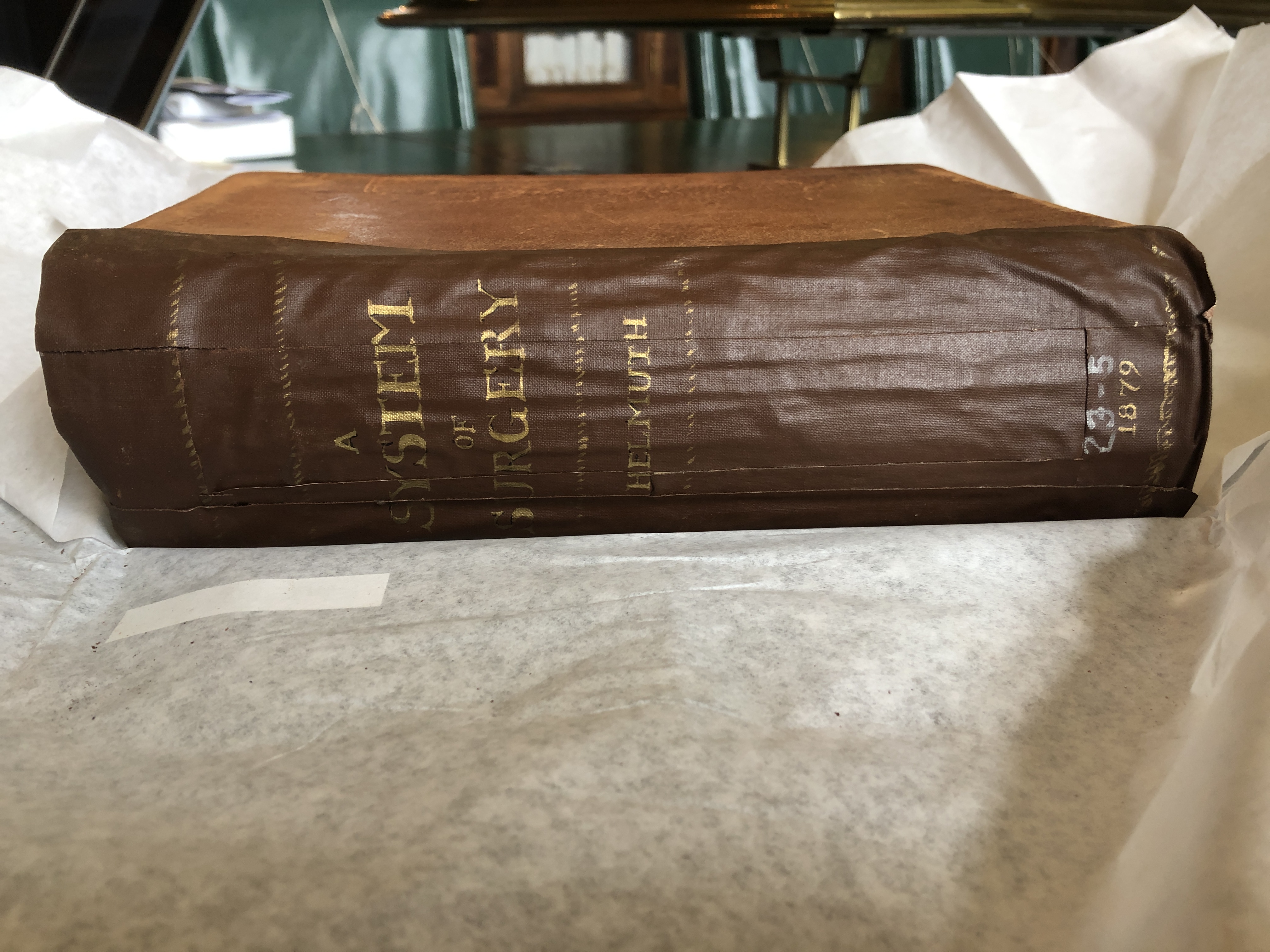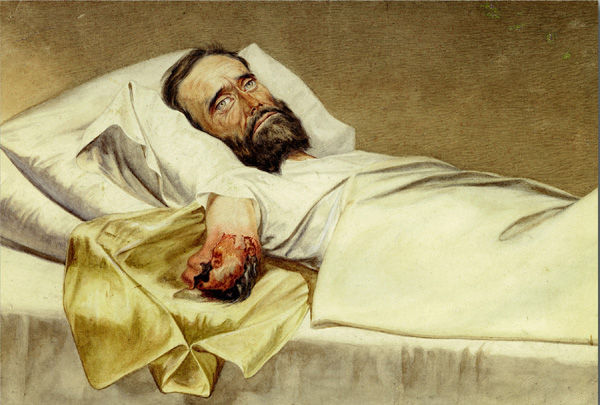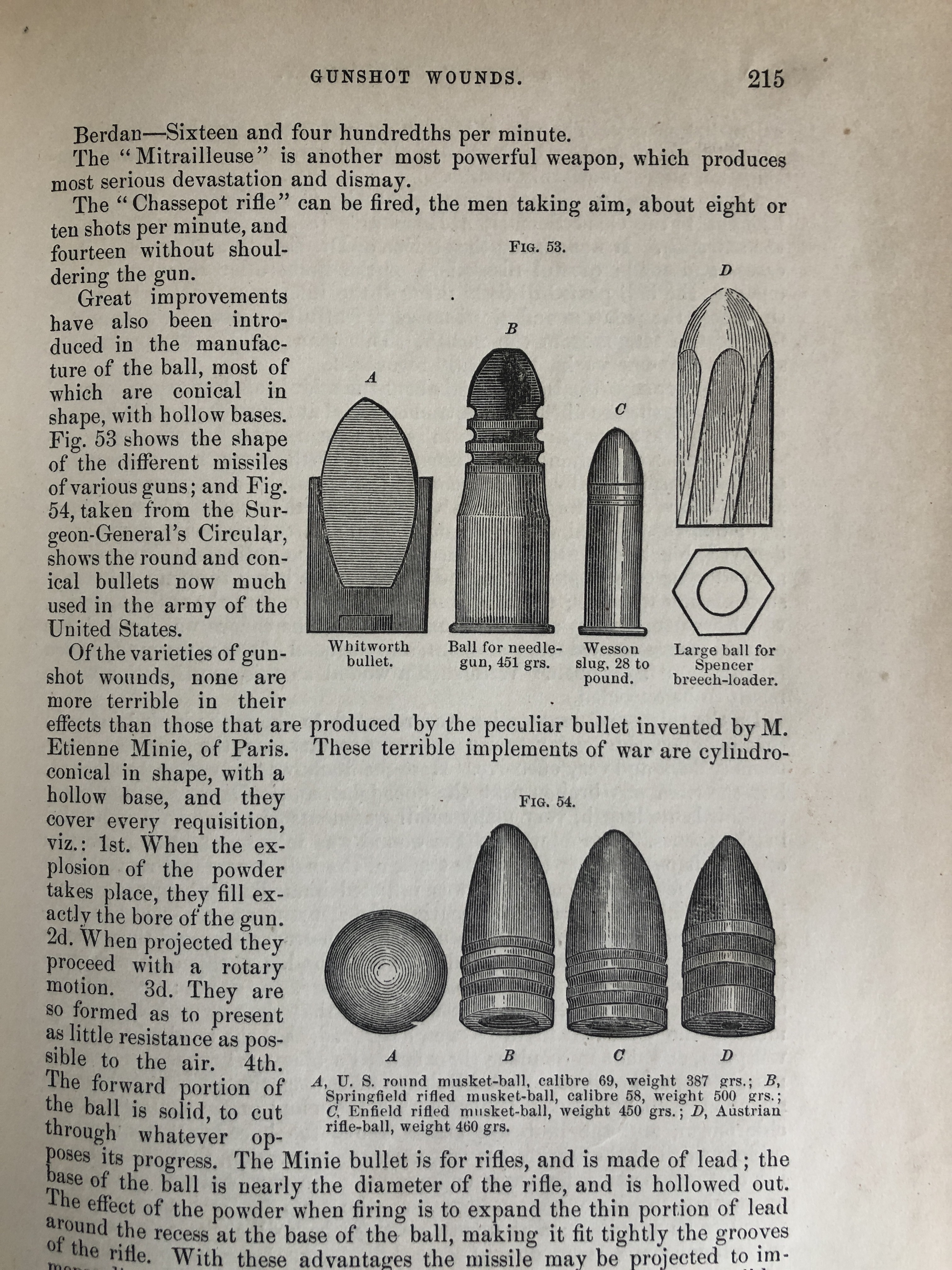Published by Kelly Christian
Many of the surgical textbooks held in the Thorek Manuscripts and Rare Books Collection reference how to operate on and care for wounds from war. The nuance of military surgery varied based on a book’s publication date, which accounts for the many differences in medical technology. Books from the late 19th century highlight specific injuries related to the American Civil War, and how to best navigate them. One of the more thorough chapters came from William Tod Helmuth’s “System for Surgery”, published in 1879. Helmuth writes in-depth about the tragedies of war as well as its implications for modern medicine. While war was rife with danger and disease, technological innovations in gun and ammunition design also had a devastating impact on the human body. Ultimately, it was the French Minié rifle and respective ball that caused much of the bodily harm in the American Civil War.

A System of Surgery by William Tod Helmuth, published in 1879. Max Thorek Rare Books and Manuscript Collection, International Museum of Surgical Science.
The American Civil War was notoriously brutal and saw the deaths of over 620,000 people. In addition to battlefield injuries, the wounded would then be prone to disease as germs spread across field hospitals. It’s estimated that for every three men that died from battlefield wounds, five died from disease,[1] which included the likes of gangrene, smallpox, and malaria. Field hospitals were frequently understaffed and lacked supplies. Despite this, field surgeons performed over 60,000 surgeries. It is estimated that nearly 45,000 of those surgeries were amputations.[2] Amputations were needed because of the vast number of bullet wounds that struck or impacted limbs. Each wound was different based on a variety of factors such as proximity to the shooter, bodily movement, the type of gun and ammunition, and atmosphere.
The design of the rifle and ammunition greatly contributed to the type and size of injury sustained. Smoothbore firearms often shot solid, spherical ammunition that could certainly cause damage on the limbs of an adversary, but its dense material and small size sent bullets in and out of limbs. The injury was obvious but the spherical bullet could cleanly pass through the body, leaving an exit wound that was nearly the same as its entry. It could break a bone or damage soft tissue. This injury, though painful and equally prone to infection, could be managed.
The more innovative Minié ball, however, was different. The ball was not round, but rather had a conical shape with rings around the bottom. It was also made of lead, a softer material than the iron that many other types of ammunition were made from.[3] William Tod Helmuth goes on to write that:
“The effect of the powder when firing is to expand the thin portion of lead around the recess at the base of the ball, making it fit tightly the grooves of the rifle. With these advantages, the missile may be project to immense distances with unerring precision, and the effects are truly terrible; bones are ground almost to powder, muscles, ligaments, and tendons torn away, and the parts otherwise so mutilated, that loss of life, certainly of limb, is almost an inevitable consequence.”[4]
The slowing down of the ammunition as it entered the body destroyed whatever it came into contact with. As the Minié ball came into contact with flesh, it left an exit sound substantially larger than its original entry point because the ammunition flattened and its impact only grew.[5] This ammunition decimated the region that the bullet hit, as noted by Helmuth. It was the unique design, speed, and accuracy that made a remarkable impact on the body.

Private Milton E. Wallen of Company C, 1st Kentucky Cavalry, wounded by a Minié ball while in prison at Richmond, July 4, 1863. He was being treated for gangrene in August 1863 when Edward Stauch traveled from Washington to make this sketch. Wallen survived the infection and was furloughed from the hospital in October 1863.
“File:Wallen wounded by Minie ball.jpg,” Wikimedia Commons, the free media repository, https://commons.wikimedia.org/w/index.php?title=File:Wallen_wounded_by_Minie_ball.jpg&oldid=399752800 (accessed March 17, 2020).
While the American Civil War was between the North and South, the complex role of international agents cannot be underscored. Claude-Étienne Minié, the inventor of the gun and its distinct ammunition, was a French Army officer who hoped to develop a rifle that could be loaded more easily and quickly in battle, and that had better accuracy. The Minié rifle and ammunition were used effectively by the British against the Russian army in the Crimean war. The gun was adapted for use by the United States military in 1855, just six years before the first bombs fell at Fort Sumter, marking the start of the American Civil War. The illustrations shared by Helmuth are the Minié, as seen here.

Excerpt from A System of Surgery by William Tod Helmuth, published in 1879. Page 215. Max Thorek Rare Books and Manuscript Collection, International Museum of Surgical Science.
The politics of the American Civil War are more relevant than ever, but the war’s effects on health is often forgotten. Medical history often serves as a reminder of how the world has changed, and how American culture has always been impacted by global innovation. The historic surgery books in the Thorek collection are evidence of how medicine responded to the tragedies of their era, and showcase the innovations that came out of a violent part of American history.
Works Cited:
- “Civil War Casualties.” American Battlefield Trust. Accessed March 17, 2020. https://www.battlefields.org/learn/articles/civil-war-casualties.
- “Maimed Men – Life and Limb: The Toll of the American Civil War.” U.S. National Library of Medicine. National Institutes of Health, July 30, 2013. https://www.nlm.nih.gov/exhibition/lifeandlimb/maimedmen.html.
- Shoop, Isaac. “Small but Deadly: The Minié Ball.” The Gettysburg Compiler, April 27, 2019. https://gettysburgcompiler.org/2019/04/30/small-but-deadly-the-minie-ball/.
- Helmuth, William Tod. 1879. A System of Surgery. New York: Boericke & Tafel, 216.
- Leonard, Pat. “The Bullet That Changed History.” The New York Times. The New York Times, September 1, 2012. https://opinionator.blogs.nytimes.com/2012/08/31/the-bullet-that-changed-history/.
Kelly Christian is the current Library Collection Intern at the International Museum of Surgical Science. She is in her second semester of graduate school at the University of Wisconsin – Milwaukee where she is pursuing her Master of Library & Information Science (MLIS), with a concentration in Archives. Kelly enjoys learning about how death and medicine have driven cultural change across American history.


